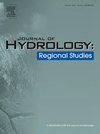历史流量变化的贝叶斯推断表明科罗拉多河流域有进一步的压力
IF 5
2区 地球科学
Q1 WATER RESOURCES
引用次数: 0
摘要
研究区域:北美科罗拉多河流域(CRB)研究重点:采用贝叶斯推理对CRB流域的长期流量进行了分析。描述长期水文气候变化的关键参数被整合到状态空间模型(SSM)中。SSM使用全球气候模式(GCMs)的结果,再加上降尺度和水文模式,为这些参数提供信息,然后根据历史观测更新这些参数。使用SSM进行了多年代际流量预测,随后应用于科罗拉多河模拟系统(CRSS)模型,以检查未来的河流系统条件。SSM预测了CRB年流量的长期下降(在平均和上下置信区间)。与一些gcm耦合模拟结果相比,SSM表明,由于气候变化,流域上游的年降水量将适度减少(例如,到2050年将比长期平均值减少2.3 %),河流流量的温度敏感性更强(每单位温度增加减少),因此河流流量下降幅度更大。2000-2023年观测到的平均流量总体上与SSM样本外验证的下降趋势一致,预计到2040年将成为平均状态,之后将进一步下降。来自CRSS的其他河流系统模型表明,尽管近年来进行了非凡的保护,但在气候变化的情况下,可能需要额外的努力来维持区域供水。本文章由计算机程序翻译,如有差异,请以英文原文为准。
Bayesian inference of historical streamflow changes suggests further stress in the Colorado River Basin
Study region
Colorado River Basin (CRB), North America
Study focus
Bayesian inference is used to analyze long-term streamflow in the CRB. Key parameters describing long-term hydroclimatic changes are integrated into a state-space model (SSM). Results from Global Climate Models (GCMs), coupled with downscaling and hydrologic modeling, are used by the SSM to inform these parameters, which are then updated based on historical observations. Multidecadal streamflow projections are made using the SSM and subsequently applied to the Colorado River Simulation System (CRSS) model to examine future river system conditions.
New hydrological insights for the region
The SSM projects a long-term decline (in both average and upper and lower confidence intervals) of annual streamflow in the CRB. Compared to some GCM-coupled modeling results, the SSM suggests a modest decrease of annual precipitation in the Upper Basin because of climate change (e.g., 2.3 % lower from the long-term average by 2050), a greater temperature sensitivity (reduction per unit temperature increase) of streamflow, and thus a larger streamflow decline. The observed averaged streamflow during 2000–2023 generally aligns with the decreasing trend in the SSM out-of-sample validations and is projected to become an average condition by ∼2040, along with further declines afterwards. Additional river system modeling from the CRSS suggests, despite extraordinary conservations in recent years, additional efforts may be necessary to sustain regional water supply amid climate change.
求助全文
通过发布文献求助,成功后即可免费获取论文全文。
去求助
来源期刊

Journal of Hydrology-Regional Studies
Earth and Planetary Sciences-Earth and Planetary Sciences (miscellaneous)
CiteScore
6.70
自引率
8.50%
发文量
284
审稿时长
60 days
期刊介绍:
Journal of Hydrology: Regional Studies publishes original research papers enhancing the science of hydrology and aiming at region-specific problems, past and future conditions, analysis, review and solutions. The journal particularly welcomes research papers that deliver new insights into region-specific hydrological processes and responses to changing conditions, as well as contributions that incorporate interdisciplinarity and translational science.
 求助内容:
求助内容: 应助结果提醒方式:
应助结果提醒方式:


